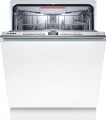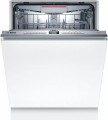Dryer type
The dishwasher has a drying function. Drying can occur both due to the natural evaporation of water from the surface of the dishes (
condensation drying), and due to its
blowing with heated air; the first option is more economical, since it does not require energy and there is also an improved one —
with a heat exchanger; the second, in turn, provides faster drying. The recently introduced new type of
Zeolith drying combines two methods, as it first collects residual moisture and then converts it into heat, which dries the dishes and belongs to premium segment models. Note that not all dishwashers are capable of drying dishes to dryness; see drying class for details.
Inverter motor
The presence of
an inverter motor in the design of the dishwasher.
Inverter motors are brushless and have higher efficiency, lower noise levels, and improved safety due to the absence of brushes. However, they are more expensive compared to conventional motors.
Energy class (new)
This parameter characterizes the efficiency of electricity consumption by a dishwasher. Classes are denotet in Latin letters from A to G, in ascending order of energy consumption. Actually, more energy-efficient models have not been added to the A class, which eventually received the marking A +, A ++, A +++. Further development of technology has made it possible to go even further, and in order not to produce pluses in energy efficiency marking, manufacturers returned to the previous indices from G to A in March 2021, where
А is the most energy efficient dishwasher. But also
class B,
C,
D and even
E are also quite economical (no worse than A +++). Accordingly, the 2021 models will have modern markings, while older models will be marked in the same way.
Energy class
The energy efficiency class characterizes the the economy of a dishwasher's electricity consumption. Initially, the classes were denoted in Latin letters from A (high degree of economy) to G (high consumption). But later, with the development of energy saving technologies, more advanced classes than A appeared. They are denoted by the letter A with a certain number of pluses (
A+,
A++, etc.); the more benefits, the higher the economy. Most modern built-in dishwashers comply with energy classes from A to
A+++(the last is 30% more economical than the original class A). More high consumption models, such as classes B and C, are much rarer and gradually disappear.
More economical models cost more, but the difference can be recouped in energy savings. Also note that the energy consumption class does not describe efficiency in general, but in comparison with other similar models; therefore, the actual consumption of a small class A device may be lower than that of a large class A++ model.
Noise class
Allows people to decode the values of the noise level in decibels. It is marked in Latin letters like other classes, where A is the quietest class of dishwashers.
Control via Internet
Ability to control the dishwasher via the Internet. Thanks to this feature, the owner can control the device from almost anywhere in the world. In addition, most of these "smart" dishwashers are also capable of sending various notifications — for example, about the end of the programme, the remaining detergent and other consumables, interruptions in the water supply, their own problems, etc.
Connecting the dishwasher to the Internet can be done in different ways, but the most commonly used module is Wi-Fi.
The specific features of Internet control may vary. For example, in some models it is carried out through a smartphone, tablet or other gadget with a special application, in others you can use any Internet browser; and the set of dishwasher functions available to the user can also be different. However, this feature provides additional convenience anyway and can be very useful — especially for those who spend most of their time away from home.

